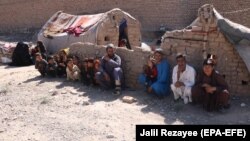Dear reader,
Welcome to Gandhara's weekly newsletter. This briefing brings you the best of our reporting from Afghanistan and Pakistan.
If you’re new to the newsletter or haven’t subscribed yet, you can do so here.
Cross-border terrorism
In a major scoop, RFE/RL’s Tajik service reports on how the Afghan Taliban has embedded and empowered radical Islamists from Tajikistan, which contradicts the group’s assurances that it won’t host international terrorists or groups that threaten Afghanistan’s neighbors.
“We know from our experiences that [Jamaat] Ansarullah -- which currently is serving the Taliban -- has many times changed its stance and objectives,” a Tajik official told us of why his country fears the militants, who previously had ties to Al-Qaeda and the Islamic Movement of Uzbekistan. “No one can guarantee that in the future Ansarullah won’t turn its back to the Taliban and attack Tajikistan,” the official added.
Ansarullah is one of several militant groups that have longstanding relations with the Taliban. Afghanistan’s neighbors worry these groups are seeking to destabilize them. Anxious over possible attacks from the separatist East Turkistan Islamic Movement (ETIM), China invited senior Taliban leaders this week to garner guarantees that the hard-line Islamists will fight against ETIM’s presence. Afghanistan’s neighbors are scrambling to prevent the fallout from the final withdrawal of international forces. (You can see our timeline, here, of the U.S. military presence in Afghanistan).
A UN report submitted to the Security Council this week revealed that Al-Qaeda is present in 15 Afghan provinces while the country is home to thousands of foreign jihadist militants.
A new mass exodus
Frud Bezhan reports on the plight of thousands of Afghans who are fleeing the escalating violence in their country as the Taliban pushes to control more territory.
“There is no prospect for peace. The war just goes on and on. So we have to go to a safe country,” “Hafizullah Naseri, a resident of Kunduz, told us as he prepared to flee. “We live in misery.”
An estimated 10,000 Afghans leave through Pakistan and Iran to get to Western Europe by making the dangerous journey through Turkey. Some 600 to 700 families are thought to migrate each week.
Within the country, many Afghans are taking refuge in provincial capitals still under government control. In this video report, we travel to Farah City, the capital of Farah Province, which the Taliban has largely overrun. Fatima, her husband, and their nine children are living in an abandoned house after their home was bombed.
“It’s the second day we don’t even have flour or cooking oil,” she told us of their struggle to survive as cities attempt to cope with the flood of internally displaced persons.
Afghan women journalists
I write about how declining press freedom and security are forcing Afghan women journalists to give up their jobs, go underground, or even flee their country while the Taliban continues its blistering offensive.
“Our homeland is like our mother. No one is able to abandon their mother,” Shakiba Saeedi, a newspaper reporter in Mazar-e Sharif, told me. “I hope that I don’t have to see the day when I or another journalist or a common citizen has to abandon our homeland.”
We also hear from a young female reporter for RFE/RL’s Radio Azadi who maintains that they are committed despite the risks to covering the issues that impact the daily lives of women and girls in areas controlled by the Taliban.
“Every time I leave home to go to work, I worry that something could happen to me,” says the reporter, whose identity can’t be revealed for her safety.
The battle for Kandahar
The toll of the unfolding violence on Afghan lives is becoming clearer in Kandahar, where traders find themselves obligated to pay taxes to both the government and the Taliban as civilians seek shelter from the incessant fighting.
“We are calling on both sides to spare our lives and give us some love, peace, and quiet,” said Kandahar resident Wali Mohmmad Badizai. “My family has already been forced to move twice, but others have been forced to move even more.”
Kandahar has been the scene of a series of reprisal killings, and the Afghan Independent Human Rights Commission says scores of civilians including activists, tribal elders, and journalists have been killed in targeted attacks. In an alarming report, the United Nations Assistance Mission to Afghanistan recorded 2,400 civilian casualties in May and June -- the highest number in those two months since the organization began its records in 2009.
Protecting Chinese interests
Reid Standish looks at how China is reevaluating the security of its projects after workers were killed in attacks in Pakistan. The reassessment comes as Beijing struggles to protect its interests in the country long touted as its closest ally and home to its multibillion energy and infrastructure investments.
“There will be more pressure on Pakistan to protect the Chinese and maybe let the Chinese take care of their own security,” said Ayesha Siddiqa, a research associate at London's School of Oriental and African Studies. “But Pakistan absolutely does not want this. They do not want Chinese boots on the ground.”
Two Chinese workers were injured in a gun attack in Karachi this week. The attack follows the killing of nine Chinese workers in a remote Pakistani region earlier this month.
I hope you enjoyed this week’s newsletter, and I encourage you to forward it to colleagues who might find it useful.
If you haven’t subscribed yet, you can do so here. I encourage you to visit our website and follow us on Twitter and Facebook.
Yours,
Abubakar Siddique
Twitter: @sid_abu
P.S.: You can always reach us at gandhara@rferl.org.
